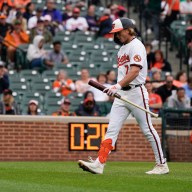The last three movies John Gallagher Jr. have made have been genre. That’s odd for him. Before he co-starred in last year’s “10 Cloverfield Lane,” he was a strictly serious actor. He was on “The Newsroom.” He made indies and dramas like “Margaret” and “Short Term 12.” He did Eugene O’Neill’s “Long Day’s Journey into Night” on Broadway. All of a sudden he was in the semi-sequel to “Cloverfield,” then the horror film “Hush.” Now he’s in “The Belko Experiment,” a bloody thriller about an office building in Colombia whose employees are trapped inside and forced to kill each other to survive. Gallagher, 32, plays an employee who definitely doesn’t want to turn to murder. It must have been something going from Eugene O’Neill to a movie where the backs of people’s heads are blown up by little implanted bombs. When I was 12 or 13, I actually started watching horror movies. But I wasn’t obsessed with gore and blood and guts. The kind of horror movies that really got me were some of the more artistically forward ones, like the early John Carpenter stuff and, of course, a lot of Alfred Hitchcock. I always dreamed of being able to do those kinds of movies. What made people want to finally cast you in more genre fare, do you think? RELATED: Celebrate the late Bill Paxton by streaming “Frailty” on Netflix Do you change up your approach at all? I mean, it’s almost the same experience, in a way, I guess? Horror’s a great genre for slipping in deep philosophical questions or transgressive ideas. Just think about Jordan Horowitz, the “La La Land” producer, at the Oscars: He was able, in a matter of seconds, to do the absolute right thing when he found out “Moonlight” had won Best Picture. That’s crazy. It’s inspiring and also depressing, because I know, push comes to shove, I wouldn’t have calmly taken charge like that. In “10 Cloverfield Lane,” you spent almost the entire movie sitting and talking. It was like theater. Here, you’re running around and doing stunts and trying not to get killed. Did you find that exhausting and trying on your body? That made me game to show up on [“Belko”] and do as much as I can legally and safely do. It ends up being fun. You feel like a kid again. When I first wanted to become an actor, it was because I was watching action movies and playing in the backyard and making up these movies in my head. Suddenly you find yourself in an office building, dodging Molotov cocktails and realizing, “Yeah, I guess this is why I got into this.” [Laughs] What were your big action movies growing up? Schwarzenegger was one of my favorite movie stars as a kid, which is weird because so many of them are R-rated. I watched “Commando” on TV, with all the gory violence edited out. You must have been stoked to work with actors like Tony Goldwyn, John C. McGinley and Michael Rooker on “Belko.” They’re great character actors who were staples of action movies and thrillers from the ’80s and ’90s.
[Laughs] It’s funny: I was a big horror-head when I grew up. It took me a few years to conquer my fear of then. I used to go through the horror aisle of the video store, looking at the back of VHS boxes and going, ‘Oh my god, that looks unbelievably scary. I never want to see that.’
A lot of the directors I came across who’ve done horror have said that when they watched “The Newsroom,” they felt I grounded some of the stakes and the dialogue in the show. They thought, “I’d love to put this guy in some extreme situations, to see how he reacts to that.”
I approach everything the same way, really. I approach Eugene O’Neill the same way I approach something like “The Belko Experiment.” They’re very different pieces, of course, but I always ask, “What does this guy want? What is he trying to do? How do I tell the truth within this story and make it real, make it believable, interesting?” But certainly doing four hours of Eugene O’Neill on stage is a little different from going to Colombia and being covered in fake blood every day. [Laughs]
You feel equally beat up at the end of the day. [Laughs]
Those are my favorite ones. A movie like “Belko,” even at the height of the absurdity, it’s still based around this moral conundrum of “Gosh, what would I do?” We all think that when the chips are down, we’ll all become a certain type of individual. But there’s no real way to know that.
Because it happens in the blink of an eye. You have the blink of an eye to make a quick, intense decision. It’s masterful to see that — to see somebody work through something super complicated and tricky and heavy in about six seconds. [Laughs]
I’d just fall on the floor and start crying. [Laughs]
Thankfully a lot of the theater I’ve done has been really physical. I did two musicals that were year-long commitments [“Spring Awakening” and “American Idiot”]. They weren’t like doing an action movie, but it was a lot of learning choreography and throwing yourself into the deep end, then doing it every night.
I still think “Die Hard” is the perfect action movie. And I loved the “Terminator”s. I definitely went through an Arnold phase as a kid, where he was my hero for a while. I was the Terminator for Halloween one year.
I definitely had a “Commando” VHS tape from network TV that I watched over and over again. I had an edited copy of “RoboCop” I watched religiously as well. When I got older and saw the unrated version, I was like, “My god! That’s so violent!”
Oh man, it was mindblowing. I look up to them so much, because they have such cool, interesting and diverse careers. They’re hardcore. They just get in there and they do it. That’s really inspiring to see actors who have been in the business for so long and are still able to be at home on a film set and ready to rock. It makes me feel like this is an awesome continuum to be a part of as a professional.
Nerding out with John Gallagher Jr. about action movies
Follow Matt Prigge on Twitter @mattprigge


















